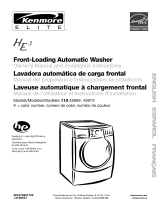
TABLEOFCONTENTS
WASHER SAFETY .......................................................................... 3
INSTALLATION REQUIREMENTS ................................................ 4
Tools and Parts ............................................................................ 4
Options ......................................................................................... 4
Location Requirements ................................................................ 5
Drain System ................................................................................ 6
Electrical Requirements ............................................................... 7
INSTALLATION INSTRUCTIONS .................................................. 7
Remove Transport System .......................................................... 7
Connect the Inlet Hoses ............................................................... 8
Route the Drain Hose ................................................................... 8
Secure the Drain Hose ................................................................. 9
Level the Washer .......................................................................... 9
Complete Installation ................................................................... 9
FEATURES AND BENEFITS ........................................................ 10
WASHER USE ............................................................................... 11
Starting Your Washer ................................................................. 11
Using the Proper Detergent ....................................................... 11
Using the Dispenser ................................................................... 12
Pausing or Restarting ................................................................. 13
Changing Cycles, Options and Modifiers .................................. 13
Status Lights .............................................................................. 13
Cycles ......................................................................................... 14
Normal Washer Sounds ............................................................. 15
Options ....................................................................................... 16
Modifiers ..................................................................................... 16
Laundry Guide ............................................................................ 17
LAUNDRY TIPS ............................................................................ 18
Loading ....................................................................................... 18
WASHER CARE ............................................................................ 19
Cleaning Your Washer ............................................................... 19
Water Inlet Hoses ....................................................................... 20
Vacation, Storage, and Moving Care ......................................... 20
TROUBLESHOOTING .................................................................. 21
ASSISTANCE OR SERVICE ......................................................... 24
WARRANTY .................................................................................. 25
J
INDICE
SEGURIDAD DE LA LAVADORA ................................................. 26
REQUISITOS DE INSTALACION ................................................. 27
Piezas y herramientas ................................................................ 27
Opciones .................................................................................... 27
Requisitos de ubicaci6n ............................................................. 28
Sistema de desag(Je .................................................................. 29
Requisitos electricos .................................................................. 30
INSTRUCCIONES DE INSTALACION ......................................... 30
Eliminaci6n del sistema protector de transporte ....................... 30
Conexi6n de las mangueras de entrada .................................... 31
Tendido de la manguera de desagOe ........................................ 31
Fijacidn de la manguera de desag(]e ......................................... 32
Nivelaci6n de la lavadora ........................................................... 32
Complete la instalaci6n .............................................................. 32
CARACTERISTICAS Y BENEFICIOS .......................................... 33
USO DE LA LAVADORA ............................................................... 34
Puesta en marcha de la lavadora .............................................. 34
Uso del detergente adecuado ................................................... 34
Uso del dep6sito ........................................................................ 35
Pausa o reanudaci6n de la marcha ........................................... 36
Cambio de ciclos, opciones y modificadores ........................... 36
Luces de estado ......................................................................... 37
Ciclos .......................................................................................... 38
Sonidos normales de la lavadora ............................................... 39
Opciones .................................................................................... 40
Modificadores ............................................................................. 40
Guia para el lavado ..................................................................... 41
CONSEJOS DE LAVANDER|A ..................................................... 41
C6mo cargar ............................................................................... 42
CUIDADO DE LA LAVADORA ..................................................... 42
C6mo limpiar su lavadora .......................................................... 42
Mangueras de entrada de agua ................................................. 43
Cuidado para las vacaciones, el almacenaje o en case de
mudanza ..................................................................................... 43
SOLUCION DE PROBLEMAS ...................................................... 44
AYUDA O SERVICIO TECNICO ................................................... 47
GARANTiA .................................................................................... 48
TABLEDESMATIERES
SECURIT¢: DE LA LAVEUSE ........................................................ 49
EXIGENCES D'INSTALLATION ................................................... 50
Outillage et pieces ...................................................................... 50
Options ....................................................................................... 50
Exigences d'emplacement ......................................................... 51
Systeme de vidange ................................................................... 52
Specifications electriques .......................................................... 53
INSTRUCTIONS D'INSTALLATION ............................................. 53
elimination des accessoires de transport .................................. 53
Raccordement des tuyaux d'alimentation ................................. 54
Acheminement du tuyau de vidange ......................................... 54
Immobilisation du tuyau de vidange .......................................... 55
Reglage de I'aplomb de la laveuse ............................................ 55
Achever I'installation .................................................................. 55
CARACTI:!:RISTIQUES ET AVANTAGES ..................................... 56
UTILISATION DE LA LAVEUSE ................................................... 57
Mise en marche de la laveuse .................................................... 57
Utilisation du detergent approprie ............................................. 57
Utilisation du distributeur ........................................................... 58
Pause ou remise en marche ....................................................... 59
Changement des programmes, options et modificateurs .........60
Temoins lumineux ...................................................................... 60
Programmes ............................................................................... 61
Sons normaux emis par la laveuse ............................................ 62
Options ....................................................................................... 63
Modificateurs .............................................................................. 63
Guide de lessivage ..................................................................... 64
CONSEILS DE LESSIVAGE .......................................................... 64
Chargement ................................................................................ 65
ENTRETIEN BE LA LAVEUSE ..................................................... 65
Nettoyage de la laveuse ............................................................. 65
Tuyaux d'arrivee d'eau ............................................................... 66
Precautions h prendre avant les vacances, un entreposage
ou un demenagement ................................................................ 66
DEPANNAGE ................................................................................. 67
ASSISTANCE OU SERVICE ......................................................... 70
GARANTI E .................................................................................... 71
IODO Le QUE I_AGINA























